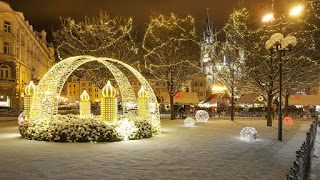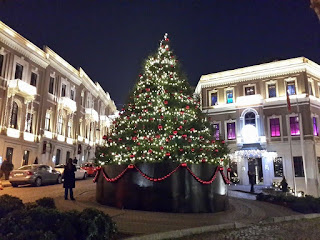Boğaziçi’nin esintileri, yalıların alt katına, cumbalı üst katlara misafir oluyor. Bahçesi “deniz” olan Muazzez Hanım Yalısı, Server Bey Yalısı, Baha Bey Yalısı ve Sadullah Bey Yalısı sıra sıra arz-ı endam ediyor. Mutluluk Destinasyonu bu hafta, ağaçların arasına saklanmış köşklerin, mütevazı ahşap konakların ve gölgesinde yaşlıların dinlendiği çınarların siluetini tamamladığı Çengelköy’de…
Şehir Hatları vapuru iskeleye yanaştıkça, rıhtımdaki yolcuların yüzleri söylüyor “Çengelköy, en güzel Marmara Denizi’nden görülüyor.” Öyle ya ağırbaşlı, kahverengi kuleli Muazzez Hanım Yalısı, kıpkırmızı Server Bey Yalısı ve beyaz boyası deniz ile karışmış Baha Bey Yalısı, aynı anda başka nasıl görülebilir ki…
 |
| Muazzez Hanım Yalısı |
1940’larda yazar Sabahattin Ali’nin bir odasını kiraladığı Baha Bey Yalısı’nda acaba hangi ‘büyük eser’ ortaya çıktı diye düşünürken; burada zaman zaman ağırladığı Bedri Rahmi Eyüboğlu ile ne ‘entelektüel sohbetler’ konu edildiğini konuşuyoruz.
Bu sırada Albanita diyor ki; “Sadece Sabahattin Ali ve Bedri Rahmi Eyüboğlu değil, Ece Ayhan, Orhan Veli, Kemalettin Tuğçu, Orhan Seyfi Orhon da bu semtte yaşadı. Orhan Veli’nin İstanbul’u dinlediği yer tam olarak Çengelköy.”
Salgın etkisi ile sakin olan iskele ve çevresinde ‘umutsuzca’ olta atıyor balıkçılar… Rızkının peşindeki kedi, köpekler ise onların etrafında boşu boşuna volta atıyor. Bankları kaldırılan iskele meydanındaki ihtiyarlar buldukları yere oturmuş, sessizce gönlündeki sıkıntıları alıp götürmesini bekliyor, vurdukça kıyıya suların… Çengelköy Karakolu’nun önündeki Ahmed Ağa Çeşmesi asırları deviren güzelliğiyle hâlâ aynı duruyor. Yivli gövdeli, kocaman lahana külahlı çeşme pek benzerine rastlayamayacağınız ihtişamıyla dikkat çekiyor.
Martıları besleyenlerin Albanita ve Bordolu Çocuk gibi burada misafir oldukları hemen kendisini ele veriyor.
Çengelköy’den Kuleli’ye doğru yürüyünce, Sumahan ve “Aya Yorgi Kilisesi” gelenleri selamlıyor. Kilise sırtlarında eski tarihlerin birinde, Düşkün Kadınlar Manastırı’nın yükseldiğini kitaplardan biliyoruz.
 |
| Sumahan |
Albanita bunun üzerine Bordolu Çocuk’a dönerek, “Balat gibi, Çengelköy’de de Ortodokslar için kutsal kabul edilen Işıklar Bayramı’nda haç çıkarma töreni yapılıyor. Böylece Hazreti İsa’nin vaftiz oluşu kutlanıyor” diyor.
800 yıldır altında soluklanıp çay yudumlayanlara gölgelik veren çınarın etrafındaki masalar toplanmış, sandalyeler ters çevrilmiş… Oturmak için sıra bekleyeceğiniz deniz seviyesindeki çay bahçesi salgın ile ıssızlığa bürünürken; ‘yalnız çınar’ hüzünlü duruyor, asırlardır hiç olmadığı gibi.
Çengelköy’de kıvrılarak dev nehir gibi uzanırken Boğaziçi, bu sırada Kaptan-ı Derya Abdullah Ağa Camii’nden yükselen ezanlar, Çınaraltı’ndaki boşlukta dağılıyor. Çengelköy’de deniz kokusuyla büyüyenler arasında dostluk var. Her ne kadar oltalar boş çıksa da denizden, balıkçılar sokak hayvanlarını besliyor. Albanita ile Bordolu Çocuk ise sadece “Semtimize hoş geldiniz” diye sevgi gösteren bir köpeği doyurmak için telaşla yollara dökülürken; aldıkları mamaya pek teveccüh gösterilmiyor patilerin sahiplerince…
Çengelköy’ün ilk adı Protos Dikos, yani “Birinci Koy” anlamına geliyor. 11. Yüzyıl’da dinî bir merkez olunca; patrikliğe aday olan kişilere verilen ‘Singelos’ unvanından Singeluhora’ya, Singelköy’e ve sonunda Çengelköy’e dönüşmüş. Semtin adıyla ilgili rivayetlerin biri de Fatih Sultan Mehmed Han’ın Bizans Dönemi’ndeki gemilerin çengellerini görerek bu adı verdiği yönünde…
 |
| Süper Baba |
90’lar efsanesi Süper Baba dizisinin çekildiği doğal plato Çengelköy, deniz kıyısında serilmiş uzanıyor gibi… II. Mahmut Çeşmesi, ‘semt zenginliği’ olarak fark ediliyor. Çeşme başında tarihî fırından aldıkları börekleri yiyen bir grup genç şakalaşıyor.
Osmanlı Dönemi’nde 16. Yüzyıl’dan itibaren bir sayfiye, av ve mesire yeri olan semt, 19. Yüzyıl’da vapur seferleri başlamasıyla insan kalabalıklarını yüklenmiş.
Mezarlığa çıkan yol, Kemalettin Tuğcu’nun adını taşıyor. 200’den fazla roman ve Yeşilçam’ın bir döneminde iz bırakan ‘Ayşecik’ filmlerinin ilkinin senaryosunun yazarı, semtin simgelerinden biri…
Kemalettin Tuğcu Sokak’tan geçip Kerime Hatun Camii’nden yukarıya yapacağınız yürüyüş sizi Devlet Konukevi’ne ulaştırıyor. Yani Ece Ayhan’ın “Deniz ve vapurlar hemen ayak altındaydı” diye anlattığı, Orhan Veli’nin İstanbul’u ‘gözleri kapalı’ dinlediği meşhur tepeye…
Tepedeki ilk köşk, Osmanlı Devleti’ndeki ünlü sarraf ve banker “Agop Köçeoğlu” tarafından yaptırılmış. Köşk, daha sonra Sultan Abdülaziz Han’ın mülkü olmuş.
Kalantor Sokak’taki yüksek duvarların ardında ve yeşilliklerin arasındaki ‘köşk ve ahşap evler’ gerçekten görülmeye değer ve unutulmaz. Albanita ile Bordolu Çocuk, Macar Fevzi Mehmet Paşa Köşkü’nden gözlerini alamıyor.
Yakınlardaki Babil Kitap ve Kafe Çengelköy’ün de Necip Fazıl Kısakürek ile millî şair Mehmet Akif Ersoy’un uğrak yeri olduğunu anmak gerekiyor.
'Filibe’ asıllı olan meşhur Köfteci Recep Usta’da mutlaka bir şeyler yemenizi de naçizane tavsiye ediyoruz. Burası daha 60’larda bile asfalt olmayan Çengelköy’ün geçirdiği değişimlerin en canlı tanığı olan bir işletme, doyumsuz köfteleri yerken; gün görmemiş hatıraları da dinleyebilirsiniz. Çengelköy’deyken fark edeceksiniz ki; pahalı rezidanslar, ultra lüks siteler, yüksek duvarların ardındaki villaların sahteliği yanında, “mahalle aslını” koruyan kültür en sahicisi…
Belki yıldızların altında ortaoyunu seyredilmiyor artık. Hristiyanların ‘Büyük Perhiz’ öncesi düzenledikleri karnavallardaki kahkahalar yükselmiyor daha… Hatta masaların arasından sokağa taşan sesiyle tambur çalınan lokantalar da yok belki… Ama Çengelköy hâlâ babaannenizin sandıktan çıkardığı beyaz sabun kokulu örtü gibi…



























































